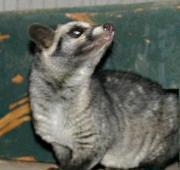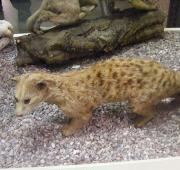 African Palm Civet Classification and Evolution
African Palm Civet Classification and EvolutionThe African Palm Civet (also commonly known as the Two-Spotted Palm Civet) is a species of Civet natively found in the tropical jungles of eastern and central Africa. Unlike the other Civet species which are all very closely related to one another, the African Palm Civet is in a genetic group of it's own, making it the most distinctive among the Civet species. The African Palm Civet is widespread throughout a number of habitats with an abundance in numbers in certain areas. The African Palm Civet is a great opportunist and is thought to be the most common forest-dwelling small carnivore in all of Africa.
 African Palm Civet Anatomy and Appearance
African Palm Civet Anatomy and Appearance
Despite their Cat-like appearance and behaviours, the African Palm Civet is not a feline at all but are in fact more closely related to other small carnivores including Genets, Weasels and Mongooses. One of the African Palm Civets most distinctive features are their brown to light-tan to yellow coloured thick fur, which is mottled with a series of darker brown spots. The fur is darker on the top half of it's body and allows the civet to be more easily camouflaged amongst the trees. The muzzle of the African Palm Civet is sharply pointed as with other Civet species, and it has strong and muscular yet relatively short limbs. They have small, rounded ears and yellow-green eyes with slit shaped pupils.
African Palm Civet Distribution and Habitat
The African Palm Civet is found inhabiting the tropical jungles and forest across much of eastern African and is even found parts of central and western Africa, where it's native habitats still exist. Today it's range extends from southern Sudan to Guinea, throughout Angola and into eastern Zimbabwe. African Palm Civets have proved to be extremely adaptable animals and are found in a wide variety of habitats from deciduous forests and lowland rainforests, to river and savanna woodlands. The African Palm Civet however is being threatened in much of it's natural range due to deforestation causing destruction to or total loss of many of their historical regions.
African Palm Civet Behaviour and Lifestyle
The African Palm Civet is a solitary animal that leads a crepuscular lifestyle, meaning that it only emerges for a few hours at dawn and dusk in order to hunt for food. They are primarily tree-dwelling creatures that spend most of the day and night hours resting in the safety and shelter of the trees. Despite being generally very solitary creatures, the African Palm Civet has been known to gather in groups of up to 15 members when food is in abundance. African Palm Civets have two sets of scent glands that secret strong-smelling substances. Found between the third and forth toes on each foot, and on the lower part of their abdomen, these glandular secretions are primarily for marking territories and are involved in mating.
African Palm Civet Reproduction and Life Cycles
African Palm Civets are able to breed twice a year in May and October during the rainy seasons, when there is more food available. The female African Palm Civet usually gives birth to up to 4 young after a gestation period that lasts for a couple of months. The babies are weaned by their mother until they are strong enough to fend for themselves when they are usually around 60 days old. The female's mammary glands produce a orange-yellow liquid which stains both her tummy and the babies fur the same colour. This is thought to discourage males that are either looking for a mate or who want to harm her young. African Palm Civets can live for up to 15 years, although few rarely get to be this old in the wild.
African Palm Civet Diet and Prey
The African Palm Civet is an omnivorous animal, and like other species of Civet, it survives on a diet comprised of both plants and other animals. Despite this, pineapples and other fruits make up the majority of it's diet. Small animals such as Rodents, Lizards, Birds and Frogs are also hunted by the African Palm Civet, along with insects. African Palm Civets feed by holding their prey in their hands and bite it powerfully a number of times to kill it, before then swallowing it whole. The long, sturdy tail is thought to be used as a brace when the Civet is balancing only on it's hind legs, and along with the thick-skinned pads on the bottom of it's feet, stabilises the African Palm Civet on the branch while its eating.
African Palm Civet Predators and Threats
Despite being a secretive yet relatively ferocious predator, the African Palm Civet is actually preyed upon by a number of predators within their natural environment. Although they do spend most of their lives in the trees, African Palm Civets come down to the ground to look for food fairly often, and will even venture outside of the forest if prey is in short supply. Large predatory Cats are the most common predators of the African Palm Civet including Lions, and Leopards that are able to hunt the Civet in the trees. Reptiles such as large Snakes and Crocodiles also hunt the African Palm Civet if given the chance. One of the biggest threats to the African Palm Civet today though is the loss of much of it's natural habitat, mainly due to deforestation.
African Palm Civet Interesting Facts and Features
The musk secreted by the glands close to the African Palm Civet's reproductive organs has been collected by Humans for hundreds of years. In it's concentrated form, the smell is said to be quite offensive to people, but much more pleasant once diluted. It was this scent that became one of the ingredients in some of the most expensive perfumes in the world. African Palm Civet females are known to produce milk from the exact number of teats as they have young, to ensure that each of their offspring has enough milk to drink and individuals are not so easily excluded during feeding time. Although it is not so common today, African Palm Civets were once commonly hunted as bushmeat in certain parts of the continent.
African Palm Civet Relationship with Humans
Farmers that live in the native habitats of the African Palm Civet view these animals very much as pests, as they are commonly known to raid poultry coops in order to get an easy meal. They are extremely persistent and abundant carnivores, which added to their secretiveness, has meant that they have caused great damage to livestock numbers in the past. Humans though have been a bigger threat to the African Palm Civet for years as they were hunted and trapped for their meat, scent and thick fur coat which is used to make traditional ceremonial garments. The destruction of the African Palm Civet's natural environment by people is thought to be the biggest threat to the species today.
African Palm Civet Conservation Status and Life Today
The African Palm Civet has been listed as an animal that is at lower risk and therefore of Least Concern of becoming extinct in the wild in the immediate future. They are known to be widely distributed, found in a variety of habitats and population numbers are also in abundance in certain areas. Today, the African Palm Civet is under threat from deforestation and has been subjected to the drastic loss of much of its natural habitat. The main reason for such extensive deforestation in these areas is either for logging or to clear the land to make way for palm oil plantations.

